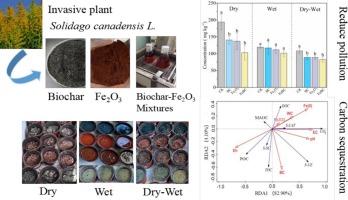在干燥条件下,生物炭和铁矿物有助于减少氯霉素污染土壤中的污染和碳的固存
IF 5
2区 农林科学
Q1 SOIL SCIENCE
引用次数: 0
摘要
解决氯霉素(CAP)污染和加强土壤有机碳(SOC)固存对环境可持续性至关重要。本研究探讨了生物炭(BC)、铁矿物(Fe2O3)及其复合材料(FeBC)在不同水分条件下(包括干、湿和干湿交替(DWA)条件下)对CAP降解和有机碳分布的综合影响。DWA条件在减少生物可利用的CAP残留方面最有效。然而,FeBC比单独的BC或Fe2O3处理表现出更好的CAP去除效率,在干燥条件下观察到最大的还原。与未添加添加剂的对照相比,DRY、WET和DWA的还原率分别达到46.98%、14.95%和23.81%。BC主要增加颗粒有机碳(POC)含量,在干燥条件下显著增加23%。相比之下,Fe2O3显著提高了矿物相关有机碳(MAOC)含量62%,在干燥条件下效果最强。然而,BC和Fe2O3在促进固碳方面没有发现协同作用。冗余分析表明,土壤湿度与POC和MAOC均呈负相关,而BC和Fe2O3分别与POC和MAOC呈正相关。此外,土壤水分、BC和Fe2O3影响土壤理化性质和酶活性,这与CAP去除和碳固存过程密切相关。生物可利用性CAP的转化与有机碳形态相关,BC增强POC和Fe2O3增强MAOC有利于CAP的固定。该研究为土壤“污染控制与固碳”一体化技术的发展提供了理论支持。本文章由计算机程序翻译,如有差异,请以英文原文为准。

Biochar and iron minerals facilitate the reduction of pollution and sequestration of carbon in chloramphenicol-contaminated soil under dry conditions
Addressing chloramphenicol (CAP) contamination and enhancing soil organic carbon (SOC) sequestration are vital for environmental sustainability. This research explored the combined influence of biochar (BC), iron mineral (Fe2O3), and their composite (FeBC) on CAP degradation and SOC distribution across various moisture regimes, including dry, wet, and dry-wet alternation (DWA) conditions. DWA conditions were the most effective at reducing bioavailable CAP residues. However, FeBC exhibited superior CAP removal efficiency over individual BC or Fe2O3 treatments, with the greatest reduction observed under dry conditions. Compared with those of the control without additives, reduction rates reached 46.98 % (DRY), 14.95 % (WET), and 23.81 % (DWA), respectively. BC primarily increased particulate organic carbon (POC) content, with a notable increase of 23 % under dry conditions. In contrast, Fe2O3 markedly increased mineral-associated organic carbon (MAOC) content by 62 %, with the strongest effect observed under dry conditions. However, no synergistic interaction between BC and Fe2O3 was detected in promoting carbon sequestration. Redundancy analysis indicated a negative correlation between soil moisture and both POC and MAOC, whereas BC and Fe2O3 showed positive correlations with POC and MAOC, respectively. Additionally, soil moisture, BC, and Fe2O3 influenced soil physicochemical properties and enzyme activities, which were closely associated with CAP removal and carbon sequestration processes. The transformation of bioavailable CAP was correlated with SOC forms: enhanced POC by BC and enhanced MAOC by Fe2O3 facilitated the fixation of CAP. This study provides theoretical support for the development of integrated “pollution control and carbon sequestration” technologies in soils.
求助全文
通过发布文献求助,成功后即可免费获取论文全文。
去求助
来源期刊

Applied Soil Ecology
农林科学-土壤科学
CiteScore
9.70
自引率
4.20%
发文量
363
审稿时长
5.3 months
期刊介绍:
Applied Soil Ecology addresses the role of soil organisms and their interactions in relation to: sustainability and productivity, nutrient cycling and other soil processes, the maintenance of soil functions, the impact of human activities on soil ecosystems and bio(techno)logical control of soil-inhabiting pests, diseases and weeds.
 求助内容:
求助内容: 应助结果提醒方式:
应助结果提醒方式:


